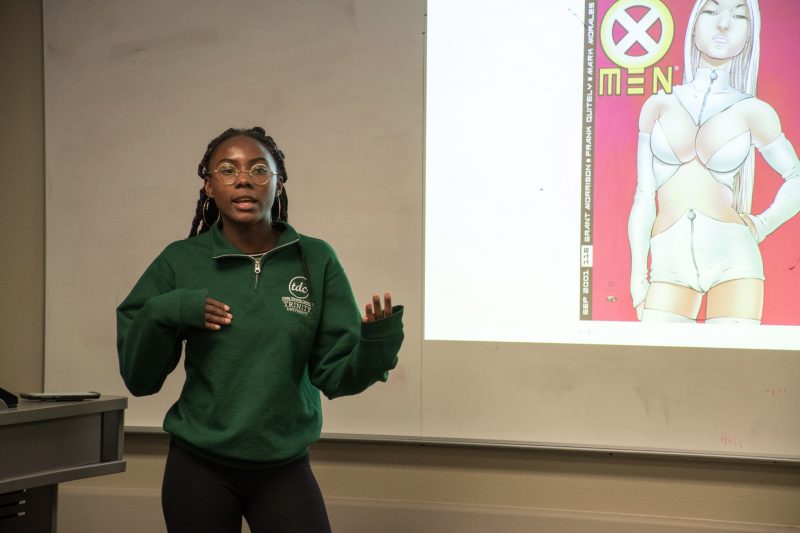In anticipation of the opening of “Black Panther,” the first major film featuring a black superhero protagonist, Trinity Diversity Connection (TDC) hosted a diversity dialogue called “Who Gets to be the Hero?” on Tuesday, Feb. 13.
Allison Roman, director of diversity and inclusion of student life, explains the context for the discussion.
“We’re hosting a private screening for the Trinity community on Feb. 22 — we’ve had a really great response, so we’re over capacity and then some,” said Roman. “We’ll be taking students, faculty and staff to go watch the film, and afterwards we’ll have a very brief discussion around initial reactions, and what does this film mean to you, because a lot of people will be able to see themselves represented in a major Marvel film.”
Kezia Nyarko, sophomore and president of TDC, described the significance of the film, whose viewing will be hosted by a variety of organizations on campus.
“For specifically black people in America, there’s never really been a representation of black super heroes,” said Nyarko. “Especially with Black Panther being from Wakanda, which is a technologically advanced isolationist fictional African country, it represents everything people of African identity hate about what colonialism did to a lot of African countries — it took them away from that prospective future.”
The film opened on Feb. 16, with showings available across San Antonio. Cindy Chiev, sophomore member of TDC’s public relations team, agreed with the importance of discussing the film’s influence beforehand.
“This event is part of the ‘Black Panther’ movie showing that TDC is also having; the title of this talk is ‘Who Gets to be a Super Hero?’, so we’re going to discuss representation of race and gender in superheroes, and how society is impacted by who gets to be called a superhero,” said Chiev. “I think it’s super important with how Hollywood and media is getting more representation of minorities, and I think it’s important to discuss it, especially at a school like Trinity, which is majority white.”
About 15 people attended the discussion. Nyarko opened the event.
“This is our first discussion of the semester and we wanted to focus it on ‘Black Panther,’ ” said Kezia. “We wanted to make sure people understood the meaning why there’s such a craze behind Black Panther and why it’s being produced by primarily a black team.”
Michael Hughes, librarian liaison for Coates University, led the discussion. As a lifelong comics fan, he too expressed interest in the upcoming film.
“I am excited about this movie in a way I haven’t been in ages. … Just when I thought I had super hero fatigue, it comes out,” said Hughes. “I think we’re on the precipice of a really exciting time.”
Hughes’ presentation focused on the history of comics, and specifically the portrayal of black superheroes in the industry, going back to the Jackie Ormes comics from 1937.
Hughes noted the racial history of representations in comics, from Whitewash Jones in “Young Allies” and Ebony White in “The Spirit,” both created by white writers, and reflecting dominant racial ideologies of the time.
Joy Umoekpo, sophomore treasurer of TDC, finds the lack of diverse representation problematic.
“I think it does matter because I think a lot of white people might not know black people,” said Umoekpo. “Just seeing them on TV might break down those stereotypes.”
Other students present at the discussion agreed with Umoekpo’s sentiments.
Black presence in the comics industry evolved in the following decades, with Black Panther’s first appearance in the Fantastic Four comics in 1966. These representations still tended to have racialized undertones, such as Luke Cage: Hero for Hire, which started running in 1972.
“Basically it was what white people imagine black people sound like …. It’s a step forward from the images we just saw [Whitewash Jones], but not what we would think of as a powerful and empowering images,” said Hughes. “Structural racism is real, and it’s real in the comics industry.”
Even now, when writers do try to include racial minorities in comics, they are met with backlash, especially from many of the fans that have long followed the characters, a movement known as #ComicsGate.
He cited people such as John C. Wright and Vox Day, both of whom criticize Marvel and DC for promoting social justice, saying that it supersedes being able to tell a good story.
“Characters come to us with decades of history, and all kinds of legacies that creators feel they need to attend to … [like] taking Peter Parker out of the game and making Spider-Man Miles Morales,” said Hughes. “You do have creators who are doing their best to diversify the space, and you have their fans who are trying their hardest not to let them.”
Hughes concluded his discussion by showcasing Lion Forge Comics. This new comics platform included titles that are interconnected, and which are attempting to bring more diversity to comic book worlds by showcasing heroes who are queer, disabled or racial minorities, among other identities.
After the talk ended, Nyarko reflected on the importance of discussions like this one.
“I wanted to have an event that came before it that helped people understand the importance of Black Panther — going to watch the movie is great, but if you don’t know why people are obsessed about it, then you don’t understand the significance of a movie like that,” Nyarko said. “More people need to show up to TDC — if you’re going to be liberal, and talk about liberalism on campus but you’re not showing up to events that talk about things, you’re fake.”







